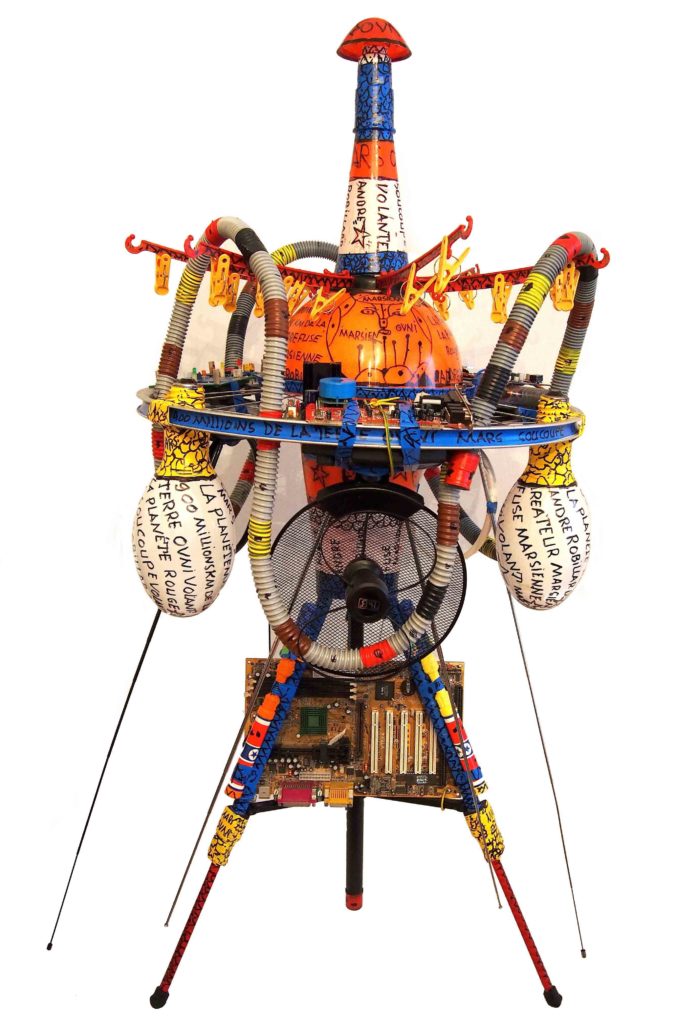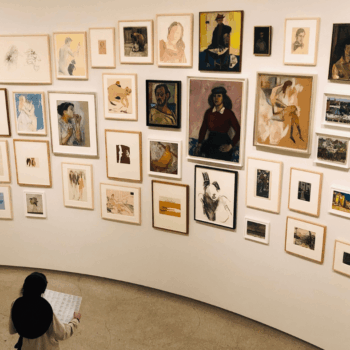
Artists boarding for space : from Robillard to INVADER
- Post published:17 January 2023
- Post category:Art Files
The stars and the stars make dream or worry the humanity. Singular artists have taken up the theme of space travel. ArtistesActuels opens its telescope to follow their intergalactic journey.
André Robillard, the uncontested artist of space

The French artist André Robillard, discovered by Jean Dubuffet and supported by Michel Nedjar, has two fields of predilection: the guns and the space. His “art things” as the artist calls them, are made from recycled materials such as cans, cables, wires, nails, light bulbs, plumbing elements, pipes and other spare parts.
He assembles them with tape and draws on them with a felt pen. André Robillard is, at almost 90 years old, a real star of the art brut. The greatest places of the Art singulier have exposed him. Thus, the Collection de l’Art Brut in Lausanne has included him in its exhibition “vehicles” in 2013-2014. Similarly, the Cooperative Cérès Franco has given him a special place in 2019 in a beautiful exhibition “Les Croqueurs d’Etoiles”.
Photos captioned with the words of André Robillard from “André Robillard. La fleur au fusil. Interviews with Françoise Monnin”. Edition La Bibliothèque des Arts
Spacecraft and the entire solar system (or almost)
If the Soviet devices inspired the artist André Robillard like the Sputnik satellite or the space station Mir, he was also interested in Martian devices, UFOs and other flying saucers. He also made many American spacecraft like the Apollo 11 rocket.
André Robillard made most of the planets of the solar system, obviously Saturn but also Neptune, Jupiter and all the others. Some are special, the earth of course, the Moon (yes it is not a planet!) with its craters and not forgetting Mars, the red planet with the American missions and the Martians. Other stars, such as the sun or the comet “All Bopp” (Hale-Bopp of its scientific name), have also been made by the artist.
In 2012, André Robillard also created an amazing solar system with planets, satellites and rockets.

Snot to mention the space adventurers
André Robillard also brought back from his artistic travels “moon rocks”. The raw artist has made several space characters such as Neil Armstrong or Laïka, the first dog in space. He also made an amazing NASA astronaut suit (with helmet and boots) that he put on himself. To travel on his UFOs or to stay directly on his Mars planets, the artist has made several Martians, green as it should be.

Dominique Lemoine, a singular artist with a thousand vehicles
As a child, Dominique Lemoine discovered the cartoon “Les Fous du volant” with Satanas and his dog Diabolo and multiple fantastic vehicles. In 2016, after discovering the fabulous catalog “Vehicles” of the Musée d’Art Brut de Lausanne, he started to draw extraordinary machines that roll, float or fly.
As an elementary school teacher, he admits to an admiration for certain children’s drawings.
Drawing for pleasure, collecting other artists
Dominique Lemoine sells his drawings on Ebay or directly on Facebook. His goal is to finance his collection of artists he likes. Today he has a collection of about 200 drawings of Pierre Albasser, Claudine Goux, Gérard Sendrey…
On Facebook, one discovers very regularly surprising novelties of inventiveness, trucks, cars, vehicles tools, vehicles man, vehicles woman, flying machines. Some of these creations have even gone into Space or have driven on other planets!
An extraordinary world to discover!
INVADER, street-artist of space
Invader, whose real name is Frank Slama, is a French street artist and mosaicist. Since 1996, he installs the series of Space Invaders on the walls of major international cities. These pixelated mosaics are made mostly without prior agreement, thus constituting what he calls “The Invasion”. In January 2021, 3,962 Space Invaders have already invaded the space of seventy-nine cities on the planet Earth.
If the street-artist represented several real characters (Serge Gainsbourg, Karl Lagerfeld, Woody Allen…) or fictitious (Spiderman, Dr House, Pink Panther…), he also realized Space invaders representing small mutant viruses of extra-terrestrial origin and resulting from the universe of the first video games.
John Byam : to the stars with wood sculptures
John Byam was an American artist (1929-2013) who worked at several jobs including gravedigger in a cemetery. Although he drew on paper, he mostly made wood carvings. In this, he is in the American tradition of rural woodcarving. However, he uses sawdust mixed with glue to finish his sculptures, giving them a blurred and uncertain appearance.
In addition, he has made numerous figurines (characters, animals…) or everyday objects (cameras, chairs, armchairs, houses…). The artist is also very interested in vehicles and especially in spacecraft.
Erich Zablatnik : Futurist artist of Space with austere universes
Erich Zablatnik is an Austrian artist (1942-1995) who was a miner in Germany and then a cook and builder. In 1989, following the accidental death of his wife and son, he attempted to end his life by driving into a wall. Severely injured, he then lived in a Caritas home.
This same year 1989 he starts to create compositions on cardboard with felt pens, acrylic paint or gouache and which represent his futuristic dreams where we see essentially spacecrafts. These rockets and other space shuttles, are realized in colors in graphic universes hyper-structured and often austere.
Karl Hans Janke : Intergalactic art to spread peace
This German artist from the former GDR (1909-1988) was interned in the psychiatric hospital of Hubertis Wermsdorf, a city that now dedicates a museum to him. His works are also presented in the collections of several Art Brut museums, starting with the Collection de l’art brut in Lausanne.
As a teenager, Karl Hans Janke attended a technical college where he developed an astonishing ability to make technical drawings and to master perspective.
Interned in a psychiatric hospital from the 1950s, he produced more than 4,500 drawings of flying technological inventions.
His drawings of spaceships, rockets and other reactors resemble the technical plans of real space machines. These are supplemented by very detailed and hyper-realistic technical notes with dates and measurements. A number of these models are “Germania Fabrikat” according to the artist. Karl Hans Janke’s objective with these devices for cosmic travel was to “spread peace” for the benefit of humanity.
Robert Saint-Rose: Poetic energy as a means of propulsion
In the 1970s, Robert Saint-Rose, a Martinican poet, worked on the project of going into space using a rocket of his own construction propelled by “poetic energy”. In this, he is inspired by the words of Aimé Césaire: “To stand up, to launch towards the sky”.
His objective is artistic but also political. Indeed, by making the first Frenchman to go into space a West Indian, Robert Saint-Rose wishes to restore pride to a people facing serious identity and economic problems.
Robert Saint-Rose was nicknamed Zetwal (Z’étoiles). The place of departure of his rocket was Volga plage. It was in 1974 in La Martinique.
In the summer of 2021, the Belgian photographer and model maker Philippe de Gobert paid tribute to Zetwal by presenting a model of his rocket at MUMA (André Malraux Museum of Modern Art) in Le Havre.

The editorial team
The thrill of artistic discoveries





